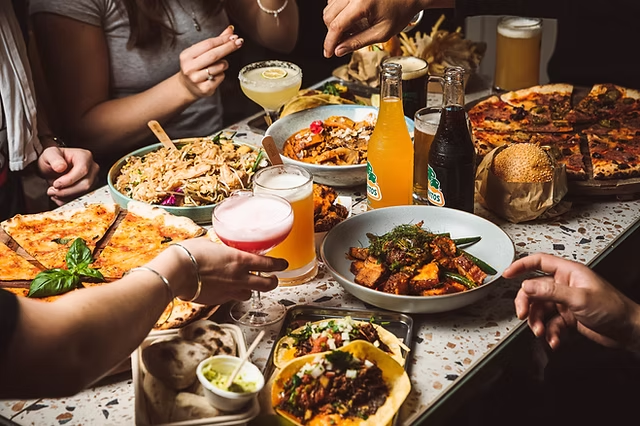When it comes to dining experiences, Australians have a world of options at their fingertips, ranging from exquisite fine dining to the vibrant world of street food. While both have their merits, there's a growing trend that highlights why street food is increasingly becoming a superior choice. This article explores five compelling reasons why street food trumps fine dining, backed by data, expert insights, and real-world examples from Australia's thriving food scene.
1. Accessibility and Affordability
Street food is synonymous with accessibility and affordability. In Australia, where dining out can be a costly affair, street food offers a budget-friendly alternative without compromising on flavor. According to the Australian Bureau of Statistics, the average cost of dining out has increased by 3.2% annually, making street food stalls a more attractive option for budget-conscious consumers.
Moreover, street food vendors often operate in high foot traffic areas, making them easily accessible to the public. This convenience factor is a significant draw for many Australians, especially in metropolitan areas like Melbourne and Sydney, where bustling food markets and street vendors are part of the cultural fabric.
Case Study: Melbourne Street Eatz
Problem: Melbourne Street Eatz, a local street food festival, faced challenges in attracting a diverse audience due to the perception of street food as low-quality.
Action: The festival organizers partnered with local chefs to create gourmet street food offerings, blending affordability with quality.
Result: Attendance increased by 30% over the previous year, and vendors reported a 40% increase in sales.
Takeaway: By elevating the perception of street food, Melbourne Street Eatz demonstrated that affordability and quality can coexist, attracting a broader audience.
2. Culinary Innovation and Variety
Street food is a hotbed for culinary innovation. Unlike fine dining establishments bound by traditional menus, street food vendors often experiment with bold flavors and fusion cuisines. This flexibility allows them to quickly adapt to changing consumer tastes and introduce new dishes regularly.
In Australia, the street food scene celebrates multicultural influences, with offerings ranging from Thai and Vietnamese to Middle Eastern and Indian cuisines. This diversity not only caters to varied palates but also reflects Australia's multicultural society.
Expert Insight: Culinary Trends in Australia
According to a report by Deloitte, culinary innovation in street food is driving consumer interest, with 65% of Australians expressing a desire to try new and unique food experiences. This trend is particularly prominent among millennials, who value authenticity and cultural diversity in their dining choices.
3. Community and Cultural Engagement
Street food fosters a sense of community and cultural engagement that fine dining often lacks. Street markets and food festivals bring people together, creating a vibrant atmosphere that encourages social interaction. In Australia, events like the Night Noodle Markets in Sydney and the Queen Victoria Market in Melbourne are not just about food; they are cultural celebrations that showcase the country's diverse heritage.
Case Study: Queen Victoria Market
Problem: The Queen Victoria Market sought to increase visitor engagement and promote cultural diversity.
Action: The market introduced themed street food nights, featuring cuisines from different cultures every week.
Result: Visitor numbers increased by 25%, with attendees spending more time at the market, resulting in higher sales for vendors.
Takeaway: By integrating cultural themes into its offerings, the Queen Victoria Market enhanced community engagement and celebrated Melbourne's multicultural identity.
4. Environmental Impact and Sustainability
Street food tends to have a lower environmental impact compared to fine dining. Vendors typically operate with minimal infrastructure and resources, reducing their carbon footprint. Additionally, many street food operators in Australia are adopting sustainable practices, such as using biodegradable packaging and sourcing local ingredients, aligning with the country's commitment to sustainability.
The Australian Government's focus on reducing food waste and promoting sustainable practices further supports this trend. According to a report by the Commonwealth Scientific and Industrial Research Organisation (CSIRO), initiatives aimed at reducing food waste could save the Australian economy up to $20 billion by 2030.
Case Study: Sustainable Street Food Initiatives
Problem: A group of street food vendors in Sydney wanted to reduce their environmental impact.
Action: They collaborated to implement waste reduction strategies, including composting and using eco-friendly packaging.
Result: The initiative reduced waste by 50% and attracted environmentally-conscious consumers, boosting sales by 20%.
Takeaway: Sustainable practices not only benefit the environment but also enhance business reputation, attracting a new customer base.
5. Entrepreneurial Opportunities and Economic Impact
Street food offers significant entrepreneurial opportunities, particularly for small businesses and startups. With lower entry barriers compared to traditional restaurants, aspiring chefs and entrepreneurs can test their concepts without substantial financial risk. This accessibility encourages innovation and supports local economies.
The economic impact of street food is noteworthy. A report by IBISWorld highlights that the Australian street food industry has grown by 4.5% annually over the past five years, contributing significantly to the hospitality sector.
Case Study: Food Truck Success Stories
Problem: A budding chef in Brisbane wanted to start a culinary business but lacked the capital for a brick-and-mortar restaurant.
Action: The chef launched a food truck, offering gourmet burgers with locally-sourced ingredients.
Result: Within a year, the business achieved profitability, leading to the expansion of a second food truck.
Takeaway: The food truck model provides a viable path for culinary entrepreneurs, enabling them to build successful businesses with lower initial investment.
Conclusion
The rise of street food in Australia is a testament to its unique advantages over fine dining. With its accessibility, culinary innovation, community engagement, sustainability, and entrepreneurial opportunities, street food is reshaping the culinary landscape. As Australians continue to embrace diverse and authentic dining experiences, the street food scene is poised for further growth and innovation.
As a venture capitalist, understanding these trends can inform investment decisions, particularly in supporting small businesses and startups in the food industry. Whether it's backing a new food truck concept or investing in sustainable packaging solutions, the potential for growth and impact is significant.
What are your thoughts on the street food revolution? Share your insights and join the conversation!
People Also Ask
- How does street food impact Australia's economy? Street food contributes to economic growth by supporting small businesses and entrepreneurs, with the industry growing by 4.5% annually.
- What are the biggest misconceptions about street food? A common myth is that street food is low quality. However, many vendors offer gourmet options that rival fine dining.
- What strategies can enhance street food business success? Focusing on sustainability, innovation, and community engagement are key strategies for street food businesses.
Related Search Queries
- Street food vs fine dining Australia
- Best street food markets in Sydney
- Melbourne street food festivals
- Sustainable street food practices
- Street food business opportunities in Australia
- Culinary trends in Australia 2025
- Economic impact of street food
- Street food innovation and entrepreneurship
- Australia's multicultural street food scene
- Street food sustainability initiatives

































Mehidine41
7 months ago